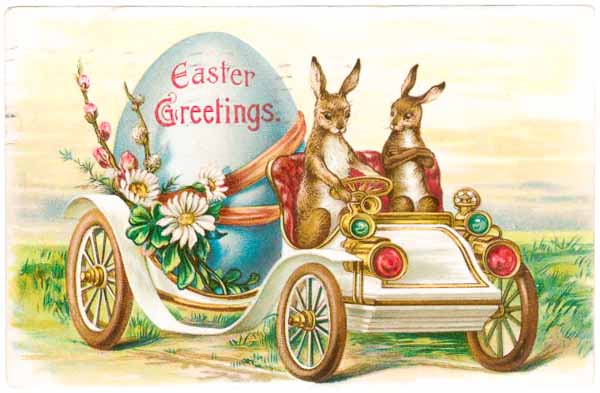
The Edwardian Easter Bunny
‘In Germany, it is the timid hare who is supposed to be responsible for the plentiful supply of brightly coloured Easter eggs so eagerly sought for by the children in all manner of hiding-places. The hare, therefore, plays a very important part in German Easter observances, and representations of the gentle, long-eared little creature are immensely popular. Indeed, they are fast acquiring a firm footing in this country also, and threaten to outrival the charms of the hens, chickens, frogs, and fish that never fail to put in an appearance whenever the glad spring festival is at hand.’ (Every Woman’s Encyclopaedia, 1910-2)
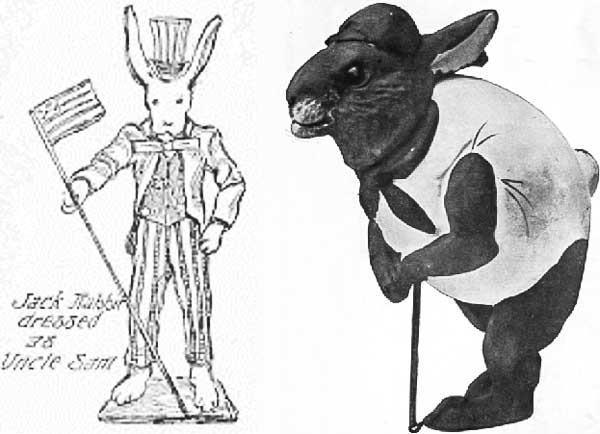
‘From Germany – rich in weird traditions – comes the quaint conceit that the week before Easter rabbits are endowed with the power to lay eggs. Young children, believing the fantasy, watch in the fields for rabbits, and when the startled creatures, seeing them, run, follow in their track, shouting the flattering entreaty, “Go, pretty rabbit, sweet rabbit, and lay me a nest of red Easter eggs.”‘ (San Francisco Call, 1901)
‘The association of rabbits with Easter or spring time is shrouded in antiquity, the development of a pagan myth. Originally the rabbit, because of its gentle nature, was regarded as the animal best typifying spring, and the idea naturally became associated with Easter.’ (Press Democrat, 1909)
History Of The Easter Egg
‘The origin of giving Easter eggs is obscure. One theory is that the egg, being emblematic of the beginning of all things, was a fitting synonymy of the resurrection – the dawn of a new life to mortals. The egg is the germ of fecundity and abundance, so with the gift of a decorated Easter egg we symbolically wish a friend all the happy fulfillment of life’s expectances, contained in the fragile shell – the one, alas! as easily and suddenly shattered as the other.
About the fourth century eggs were prohibited by the church as a Lenten diet, and, being more plentiful in the spring than at any other time, there was such an accumulation at the end ot the forty days that peasant and epicure were alike puzzled to contrive a way to dispose of them without loss. It is said some inventive mother converted them into playthings for her children; hence the custom of boiling and coloring them.
The Easter egg, born of economy, has evoluted during the centuries till 1901 finds it often a thing of extravagance and price. Paris – ever in excess, be it pleasure, misery or lavishness – a few years ago conceived and executed a most beautiful Easter offering for the Infanta of Spain. Within a delicate white porcelain shell engraved with the gospel for Easter nestled a tiny bird, which, upon the pressure of a cunningly devised spring, came forth and sang twelve airs from as many fashionable operas. This ingenious toy cost France 20,000 francs. […]
On Easter morning at the conclusion of mass lackeys brought pyramids of gilded eggs to the palace and, after being blessed by the priests, they were distributed to persons about the court. In some parts of France it is still the custom for priests to visit their parishioners and bestow blessings, receiving in return Easter eggs. […]
In solid comfort-loving but thrifty and prudent Germany the Easter eggs for sale in shop windows, though often novel in device and brilliant in coloring, rarely exceed in price two or three gulden.
In Italy the peasants rejoiced in the belief that during the chiming of the bells on Easter morning angels with azure wings descended and placed baskets of colored eggs in the homes of the faithful. After church it was customary for neighbors to meet and match eggs. […]
In Moscow gifts are exchanged as with us at Christmas, and the streets are filled with children singing Easter anthems and bearing gifts to friends and relatives.
The Swiss mountains and valleys resound with Tyrolean airs as the gay Tyrolese in picturesque attire, with zithers adorned with ribbons and garlands go from house to house serenading, being rewarded by presents of eggs. […]
With the Romans as with the Franks under the Capets the year began at Easter. The repast of the Romans invariably began with the eating of an egg, and with the breaking of the shell they exclaimed. “From the egg e’en unto the apples!” […]
The grounds of the White House in Washington are gay on Easter morning with children, who assemble to roll eggs down a terrace. For children whose parents can afford to buy them there are innumerable beautiful novelties, while the mother with small means and abundance of love can, as in times gone by, purchase a few cents worth of colored calico or dye and boil the eggs till they are so brightly colored that the sight of them on Easter morn will give her children an equal pleasure with the children of the rich.’ (San Francisco Call, 1901)
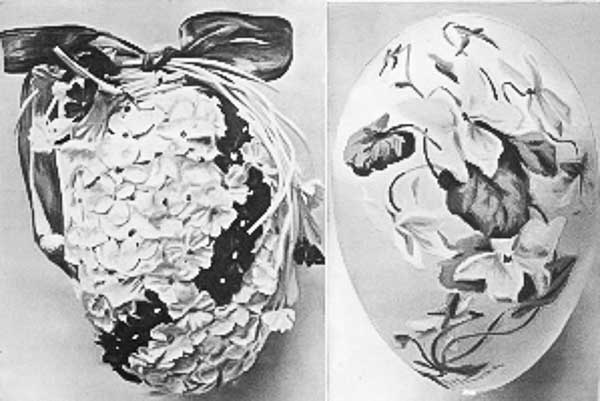
‘The custom of exchanging curiously decorated and coloured eggs on Easter Day, primarily as sacred memorials, and secondarily as tokens of friendship and affection, commenced in very early days, has continued up to the present, and it is interesting to note the various ingenious methods employed throughout the centuries for the embellishment of these fragile offerings.
Italy was the home of many beautifully designed and elaborately painted Easter eggs, which, we are told, were frequently presented as gifts to ladies of quality. […] It was formerly an ancient custom in Cheshire for children of the poorer classes to go round the villages, begging eggs for their Easter dinner. They sang a short song, begging for “An egg, bacon, cheese, or an apple, or any good thing to make us merry,” ending with, “And I pray you, good dame, an Easter egg.”
Good old customs die hard, and now, as yet another year brings round Eastertide once more, we look for the bright and spring-like gifts prepared in anticipation of the great festival. […] Though in England it is principally children who expect to receive eggs on Easter Day, whether it be the short-lived chocolate or sugar variety, or the more substantial kind, containing toys, many very beautiful specimens are prepared as gifts for grown-up persons, or for Easter table adornments.’ (Every Woman’s Encyclopaedia, 1910-2)
Edwardian Hand Painted And Dyed Easter Eggs
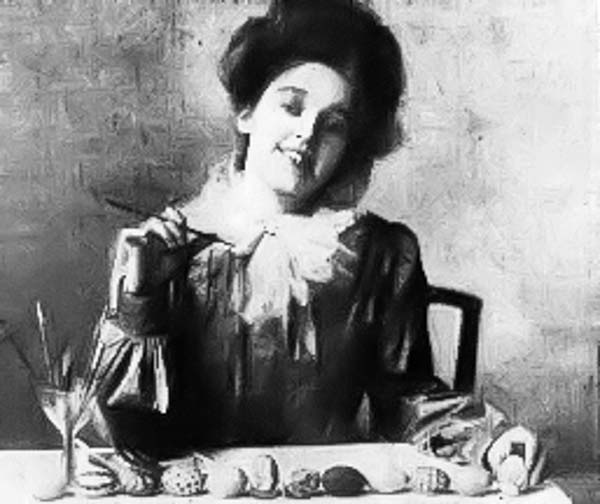
‘In families where eggs are served for breakfast Easter Sunday morning it is the custom to serve eggs both hot and cold, hard boiled and soft boiled. The old Dutch custom of giving eggs, and as many of them as possible, is still preserved in many families. who boast descent from the Holland Dutch.
To decorate a dish of hard boiled eggs in quick and pretty fashion take the eggs the day before Easter and boil them nearly half an hour. They should be boiled until their contents are mealy, not pasty. […] When the eggs have been well boiled they must be plunged into cold water. This makes them peel more easily at the critical moment.
Then when they have cooled, the artistic girl who is going to paint them lays them in a row before her on the table. Taking her paint brushes she crosses an egg in green and scarlet and blue, making a Scotch plaid. The next egg she decorates in spots and dots, some hollow and some in the shape of great big round spots. Upon the third egg she paints a star fish with great starlike shape, sprawling all over the egg. And upon the next she quickly sketches a bird singing upon the branch of a tree. Then there is the daisy egg, all the little daisies, and the egg which is painted yellow and scarlet and white, like a sunset.
It is quick work this putting together of the colors, and the eggs are painted before one realizes that the work has begun. They are then placed tenderly in a dish so that their best points will show and Easter Sunday morning they are brought out for the breakfast table. If preserved they can be kept for the supper table, for the Easter egg is popular all Easter day.
The dyed egg is not at all difficult to achieve. The egg is plunged into hot water in which there is just a little dye. It is boiled and taken out. This can be done just before breakfast so that the eggs will be hot. Harmless dyes can be procured and the eggs are not spoiled for the eating.’ (San Francisco Call, 1904)
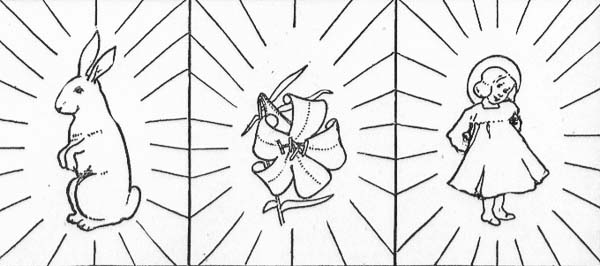
‘To reproduce the pictures upon eggs first cut off the square and make cuts indicated by the radiating lines. Take a pin and after laying the picture upon cloth or other soft surface, prick the outlines of the drawing. This should be done very carefully, having the holes of equal size and evenly spaced, so that when this is completed and the paper held to the light the picture will be clearly shown by the holes. Lay the paper upon a hard boiled egg tightly. The slits will enable you to fit the paper to the egg. Take a brush with ink or a piece of cloth wet with ink and paint over the holes. If carefully done the picture will be seen perfectly reproduced upon the egg when the paper is removed. Next join the dots so that the outline of the drawing on the egg is an unbroken line. Color with water colors or colored inks. White eggs should be used.’ (Los Angeles Herald, 1905)
Edwardian Easter Eggs Dyed With Calico
‘Easter eggs were a great thing with us little girls in Virginia. I do not remember whether there was any talk of new Easter clothes; but, then that would have been in our eyes a small matter in comparison.
The prettiest ones by far were dyed with calico. Get the calico either small figured, wee sprigs of flowers and the like, or with a flower large enough to decorate the whole side of the egg. A piece about 4 by 7 inches will serve the purpose or two pieces 3 1/2 by 4 inches […] In covering put the right side of the goods to the egg, and tack, or pin the calico tight over it, and follow this tacking with close sewing (see illustration), drawing the calico tight and as smooth as possible, especially where the figures are, as you wish the figures to lie flat against the egg, and whole figures, if possible, rather than parts. Outside of these smooth places the plaits and ridges (resembling the spurs of a mountain range) need extra stitches and extra tightening to adjust them right.
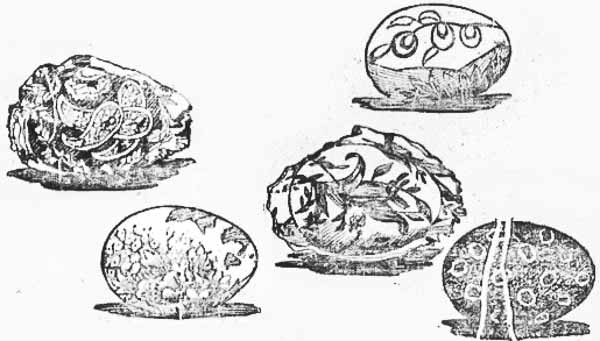
We were advised to use calicoes which faded easily, but that was exaggerated advice. The tolerably fast dark colors succeed better. The brown, black or scarlet of good, fast colored prints scarcely color the egg at all. Purple seams desirable and dark blue. Deep pink roses often come out beautiful. A white or very light ground is generally best. Prints not intended to be washed do well. For instance, the cheaper draperies, like thick silkoline and the thin furniture coverings, especially old fashioned “curtain calico”[…]
We boiled our eggs (thus sewed in their covers) in weakened lye, but I, living in town, boil them in washing soda and water, a lump the size of a walnut to a quart or less, which boils down generally to still less. Put the eggs into the boiling mixture at any time, only be sure that the soda is fully dissolved. Let them boil nearly half an hour. If your calico is, however, of somewhat fast colors, an hour may be better. The danger is of boiling off the pictures which you have boiled on. The fast colors will stand a good deal of boiling, getting prettier and prettier, whereas the less fast may soon begin to fade out of the egg as well as out of the covering.
Use a spoon in handling the wet egg. Soda or lye eats the skin. Do not boil many at once in a can if there is a danger of the colors running much. The picture shows eggs wrapped in cloth and also after the cloth is removed.
If all this is too much for the family patience, there is another entertaining way. Get some of the ready prepared egg dyes, to be used cold, boil the eggs hard and after they are thoroughly cooled mark words or figures upon them with melted wax. Then dye and afterward carefully tear off the wax.’ (Sotoyome Scimitar, 1904)